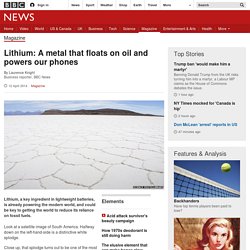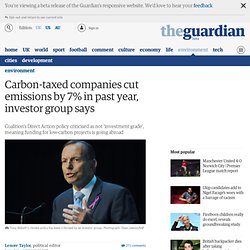

Obama announces first-ever limits on CO2 emissions. After failing to introduce large changes in emissions targets in his first term, President Obama has now directed the EPA to introduce cuts of up to 30 per cent in carbon dioxide emissions by 2030.

Photo: AFP The Obama administration has announced regulations that would cut the amount of carbon dioxide the US energy sector may emit by 30 per cent on 2005 levels by 2030, the first ever national limits on the green house gas introduced in the United States. The new limits are designed to spur states to phase out reliance on coal fired power, promote clean energy innovation and put the United States in a better position to influence other nations at upcoming United Nations climate talks. Guest Post: Burning Buried Sunshine. Oil – The Least Efficient Source of Energy By Scott McNally Solar energy is often criticized for its inefficiency – that only about 10% of the sunlight that hits a common commercial solar panel will be converted into electricity.

Similar criticisms are voiced against biofuels, which have a solar energy to biofuel conversion efficiency of less than about 2%.* But how do these efficiencies compare to other sources of energy, like oil? Turns out – solar and biofuels do pretty well. First consider this; we truly have three primary sources of energy: nuclear, geothermal, and solar**. What a win-win on unburnable carbon looks like. The recent IPCC report is clear: We need a dramatic change in the design of the global economy to avoid climate catastrophe and we need it now.

The International Energy Agency estimates that to stay within 2 degrees Celsius of atmospheric warming, the global economy will have to avert emitting the carbon from roughly 80 percent of world’s proven reserves of fossil fuels. This is called unburnable carbon. It does not include the carbon from shale oil and gas being extracted through fracking. We need an apartheid-style boycott to save the planet. 'The negative impacts of Keystone XL will affect the whole world, our shared world, the only world we have.' Photograph: Sue Ogrocki/AP Twenty-five years ago people could be excused for not knowing much, or doing much, about climate change.

Today we have no excuse. No more can it be dismissed as science fiction; we are already feeling the effects. Lithium: A metal that floats on oil and powers our phones. Lithium, a key ingredient in lightweight batteries, is already powering the modern world, and could be key to getting the world to reduce its reliance on fossil fuels.

Look at a satellite image of South America. Halfway down on the left-hand-side is a distinctive white splodge. Close up, that splodge turns out to be one of the most extraordinary and unspoilt places on earth, the world's biggest salt flat. It is a crisp, perfectly flat white plain, like freshly fallen snow, 100km (60 miles) across and 3,600m (12,000ft) up in the remote Bolivian Andes. Desmond Tutu calls for anti-apartheid style boycott of fossil fuel industry. Archbishop Desmond Tutu has called for an anti-apartheid-style boycott and disinvestment campaign against the fossil fuel industry for driving global warming, just days ahead of a landmark UN report on how carbon emissions can be slashed.

In an article for the Guardian, the archbishop writes: "We live in a world dominated by greed. We have allowed the interests of capital to outweigh the interests of human beings and our Earth. It is clear [the companies] are not simply going to give up; they stand to make too much money. " Western Australia wave energy project on the brink of commercialisation. World Economic Forum - Scoping Paper: Mining and Metals in a Sustainable World. Could future chairs, clothes and even buildings be made from carbon emissions? Finding materials that are both sustainable and affordable has long been a central quandary in sustainable design.

Certainly, high-cost, high-end materials, like sustainably-sourced hardwoods and post-consumer paper products, exist. The disruptive potential of solar power. The economics of solar power are improving.

It is a far more cost-competitive power source today than it was in the mid-2000s, when installations and manufacturing were taking off, subsidies were generous, and investors were piling in. Consumption continued rising even as the MAC Global Solar Energy Index fell by 50 percent between 2011 and the end of 2013, a period when dozens of solar companies went bankrupt, shut down, or changed hands at fire-sale prices. The bottom line: the financial crisis, cheap natural gas, subsidy cuts by cash-strapped governments, and a flood of imports from Chinese solar-panel manufacturers have profoundly challenged the industry’s short-term performance.
But they haven’t undermined its potential; indeed, global installations have continued to rise—by over 50 percent a year, on average, since 2006. Economic fundamentals Sharply declining costs are the key to this potential. Norwegian wealth fund may ditch Australian resource firms. Some of Australia's biggest resource companies could lose a major investor if Norway goes through with a plan to ban its famous sovereign wealth fund from investing in coal, oil and gas.

Carbon-taxed companies cut emissions by 7% in past year, investor group says. Greenhouse emissions from Australian companies paying the carbon tax have fallen by 7% over the past year “in large part” due to the carbon price impost, the Investor Group on Climate Change has said.

Emissions rise as coal makes a comeback. Coal mining. Carbon emissions from Australia's main power market have increased for the first time in two years as coal makes a comeback in the country's energy mix, according to energy consultants Pitt & Sherry. Black and brown coal-fired power plants supplied 75.2 per cent of the NEM’s power last month, up from 73.8 per cent a year earlier. A reduction in Snowy Hydro’s output also helped drag down the share of power from renewable sources, said Hugh Saddler, principal consultant with Pitt & Sherry. Australia’s stationary power industry, which is directly covered by the carbon price, has been one of the few sectors of the economy to show a reduction in carbon emissions.
In the year to last September, the industry’s emissions totalled 178.7 million tonnes of carbon dioxide equivalent, according to government data. Advertisement Soaring gas costs as domestic prices rise towards global levels have also prompted generators to lower or even close gas-fired power stations, such as in Queensland.
Global solar PV capacity jumped by third in 2013, industry says. Santos coal seam gas project contaminates aquifer. In waiting: Grazier and protester Ted Borowski lies in a dry creek bed ready to disrupt drilling operations in the Pilliga forest by locking himself to a truck.